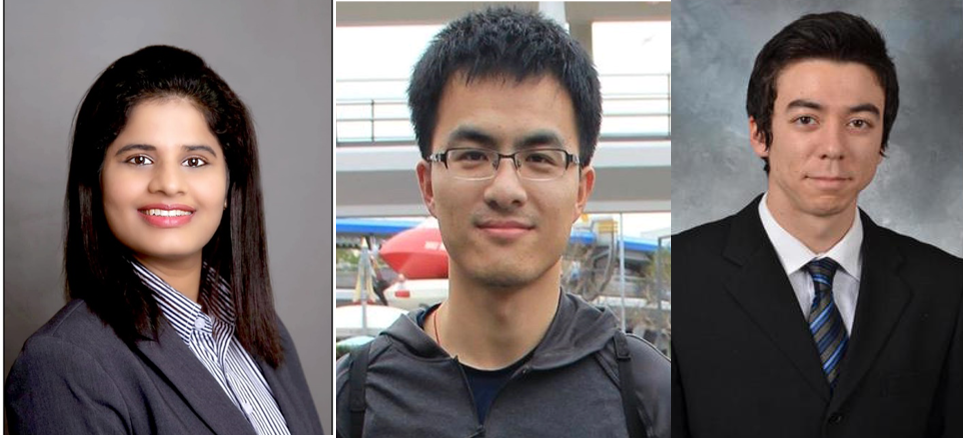In the Hsiao Group, science that’s pure and (not so) simple

(L-R: Priyanka Sharma, Kai Chi and Ken Johnson)
They don’t give the Prince Sultan bin Abdulaziz International Prize for Water to just anybody, you know.
But constant breakthroughs, and the occasional accolade, are part of the action in the Benjamin S. Hsiao Research Group, where effective water purification for developing communities is the focus, and nanocellulose – a microscopic fiber with galactic implications – sets the tone.
The Saudi Arabian scientific prize – actually a series of prizes, honoring surface-water efforts, groundwater projects, resource-management innovations and more – was established in 2002 by Prince Sultan Bin Abdulaziz Al Saud. The bi-annual Creativity Prize celebrates interdisciplinary work leading to a major scientific breakthrough in any water-related field; in 2020, the Hsiao Group captured the prestigious honor.
The team, led by Distinguished Professor Benjamin Hsiao, has developed adsorbents, coagulants and membrane materials from biomass-sourced nanocellulose fibers – which are the tiniest of tiny but pack a wide range of practical applications, including astonishingly effective water-purification technologies for off-grid communities and the developing world.
Hsiao’s team – which includes Stony Brook University Associate Professor Priyanka Sharma, winner of a 2021 Young Academic Inventor’s Award from the National Academy of Inventors (NAI) – also develops environmentally friendly biomass-extraction processes (wood is a terrific source).
The idea is to produce an abundance of low-cost cellulose nanofibers ideal for up-and-coming desalination, heavy metal-removal and other water-treatment technologies already proven to outperform contemporary commercial water systems. It’s an ambitious two-pronged approach, but Dr. Hsiao – a former SBU vice president and chief research officer – is very familiar with the rarified air of new discovery.
A co-founding director of the Turkana Basin-based Innovative Global Energy Solutions Center, the distinguished professor – who also directs the university’s Center for Integrated Electric Energy Systems (CIEES) – has collected nearly two dozen awards and fellowships, including acceptance to the American Chemical Society, the NAI and other prominent scientific organizations.
And he’s “a very nice person,” according to Dr. Sharma, who describes Dr. Hsiao as “a very good mentor and always very eager to help his students.”
“He not only listens to student problems but provides suitable solutions to them,” the associate professor adds. “He is an excellent scientist with innovative ideas and has high skill of expertise.”
Following the leader, the Hsiao Group is stocked with scientific talent. By “upcycling” biomass waste into valuable cellulose nanofibers, Dr. Sharma is leading efforts to develop “less-chemically oriented processes” for extracting biomass waste from cheap, abundant sources – addressing needs in both water purification and advanced energy storage.
Post-doc researcher Kai Chi also plays a critical role in that upscaling effort – lignocellulosic biomass valorization is the bomb, he says – and agrees that Dr. Hsiao is “a very resourceful mentor.”
“Dr. Hsiao has tremendous solutions to water contamination issues,” Dr. Chi notes. “And we have very useful characterization techniques in the [Thermomechanical & Imagining Nanoscale Characterization] facility – including microscopy imaging, elementary analysis and thermal characterizations – that greatly contribute to our research.”
Working inside the ThINC laboratories, a core facility of SBU’s Advanced Energy Research and Technology Center (AERTC), is definitely an advantage, according to graduate student Ken Johnson, who feels lucky to be pursuing his PhD in chemistry on the Stony Brook campus.
“The AERTC community is so valuable, in that it allows for us to find and build connections with potential colleagues, partners, mentors and clients,” Johnson says. “Many of us working at AERTC have similar goals in mind.
“Dr. Hsiao is humble and gracious as a mentor,” he adds. “He tries his best to be available for his mentees and facilitate their research.”
And of course, the ThINC instrumentation is key – Johnson is a big fan of electron microscopy and thermal imagery – as the Hsiao Group attempts to pump biomass-based water purifiers to industrial strength.
“We propose using underutilized, cellulose-based biomass as our starting material … because of its low or zero price tag,” Johnson says. “Our aim is to create a model for how the process could be scaled up industrially and commercialized in the future.”
As the group’s unique, recently published oxidation methods (key to extracting cellulose nanofibers from wood) fuel new batch reactors and other next-gen processes, it will continue to enjoy Dr. Hsiao’s tutelage, according to Dr. Sharma – along with the AERTC’s abundant resources.
“I had a chance to interact several times with the members of ThINC facility, and I found that they have a good time commitment,” the associate professor says. “The whole AERTC community is very helpful.”
